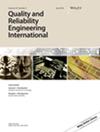对数位置尺度增量退化模型:贝叶斯视角
IF 2.8
3区 工程技术
Q3 ENGINEERING, INDUSTRIAL
引用次数: 0
摘要
降解模型是评估高可靠性产品寿命信息的重要工具。描述降解现象的一种常用方法是使用依赖于随机过程的降解模型。在基于随机过程的降解模型中,假定增量遵循具有可加性的分布。这一特性使得进一步的推论在数学和统计学上更加容易。不过,这也限制了对分布的选择。本文旨在使用那些不具有可加性的分布来模拟增量,并探索对数定位尺度系列的分布。在贝叶斯分析框架下,开发了马尔可夫链蒙特卡罗算法来执行必要的计算。鉴于所提出的降解模型不符合可加性属性,本文探讨了预测在线和离线产品寿命所涉及的挑战。随后分析了两个示例,以演示所概述的程序步骤。最后通过模拟研究验证了所建议模型的适用性。本文章由计算机程序翻译,如有差异,请以英文原文为准。
Log‐location‐scale increment degradation model: A Bayesian perspective
Degradation modeling serves as a valuable tool for assessing the lifetime information of highly reliable products. One frequently employed approach for describing the degradation phenomenon involves the use of a degradation model that relies on stochastic processes. In a stochastic‐process‐based degradation model, it is assumed that the increments follow a distribution with the additivity property. This property makes the further inferences mathematically and statistically tractable. However, it limits the choices of the distributions. This paper aims to use those distributions without the additivity property to model the increments and explores distributions from the log‐location‐scale family. Under the frame of Bayesian analysis, Markov Chain Monte Carlo algorithms are developed for executing the necessary computations. Given that the proposed degradation models do not adhere to the additivity property, this paper tackles the challenges involved in predicting the lifetime of both on‐line and off‐line products. Two illustrative examples are subsequently analyzed to demonstrate the procedural steps outlined. The suitability of the proposed model is finally validated through a simulation study.
求助全文
通过发布文献求助,成功后即可免费获取论文全文。
去求助
来源期刊
CiteScore
4.90
自引率
21.70%
发文量
181
审稿时长
6 months
期刊介绍:
Quality and Reliability Engineering International is a journal devoted to practical engineering aspects of quality and reliability. A refereed technical journal published eight times per year, it covers the development and practical application of existing theoretical methods, research and industrial practices. Articles in the journal will be concerned with case studies, tutorial-type reviews and also with applications of new or well-known theory to the solution of actual quality and reliability problems in engineering.
Papers describing the use of mathematical and statistical tools to solve real life industrial problems are encouraged, provided that the emphasis is placed on practical applications and demonstrated case studies.
The scope of the journal is intended to include components, physics of failure, equipment and systems from the fields of electronic, electrical, mechanical and systems engineering. The areas of communications, aerospace, automotive, railways, shipboard equipment, control engineering and consumer products are all covered by the journal.
Quality and reliability of hardware as well as software are covered. Papers on software engineering and its impact on product quality and reliability are encouraged. The journal will also cover the management of quality and reliability in the engineering industry.
Special issues on a variety of key topics are published every year and contribute to the enhancement of Quality and Reliability Engineering International as a major reference in its field.

 求助内容:
求助内容: 应助结果提醒方式:
应助结果提醒方式:


